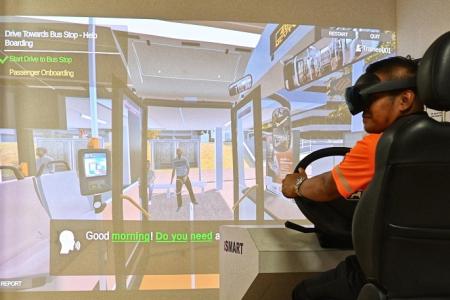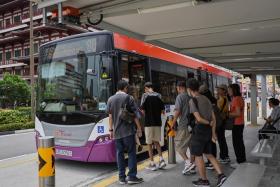Bus drivers learn how to help passengers with different needs
Mr Nasharudin Mohamed is a trainee bus driver who has not yet encountered actual passengers with disabilities, wheelchair users, passengers with prams or the elderly.
But he said he feels prepared to help such passengers with different needs after undergoing training to do so on a mixed-reality simulator at SBS Transit’s (SBST) Bus Captain Training and Certification Centre.
According to Mr Nasharudin, 32, the simulator is “more realistic” than face-to-face role-play sessions with colleagues, which SBST has been using for such training.
Describing a simulated training scenario with a visually impaired passenger as particularly helpful, he said: “As visually impaired passengers can’t see you, they’re more (sensitive) to... touch.
“You need to make sure that they are comfortable with your touch, and make sure they are seated to ensure their safety before you continue the journey.”
Mr Nasharudin was speaking on Sept 24 during a media tour of the centre at Ulu Pandan bus depot.
The centre was relocated in April from the Hougang bus depot to optimise the use of combined training resources for bus drivers and technicians. Bus drivers were previously trained at the Hougang depot, while bus technicians were trained at Ulu Pandan.
In June, the centre introduced the mixed-reality simulator, which includes a physical driving console complete with brakes, a mixed-reality headset and ample space for a trainee to walk around – and even outside – the “bus” to act out various training scenarios.
The simulator assesses trainees’ performance by tracking and analysing their eye movements, facial expressions, hand gestures, articulation of words, and how well they handle each scenario.
Currently on trial with four scenarios in the system, the simulator is used by only some trainees and existing bus captains undergoing a refresher course for customer service.
In 2025, SBST expects to increase its total number of simulators to three, and to expand the scope of scenarios to include incidents such as bus breakdowns or passengers fainting on a bus.
With three simulators set to be in place in 2025, the public transport operator hopes to roll out the use of the mixed-reality training to all new bus drivers then, as part of the centre’s 27-day training programme.
Since the centre’s relocation in April, almost 240 trainees have graduated from the programme. It is expected to train 650 bus drivers every year.
Mr Lim Tien Hock, chief executive officer of SBST’s bus business, said during the media tour that training technologies at the centre have been and will be put in place to enhance training for bus drivers, in addition to elevating their proficiency in driving and practising road safety.
The centre currently offers the mixed-reality simulator for customer service training, hazard awareness training in the form of interactive videos, and a driver training system that evaluates a trainee’s driving competencies using sensors and cameras.
Get The New Paper on your phone with the free TNP app. Download from the Apple App Store or Google Play Store now


